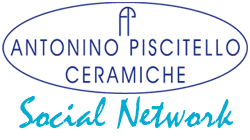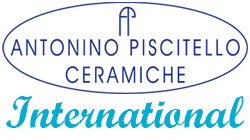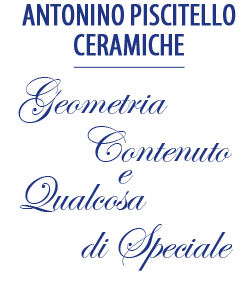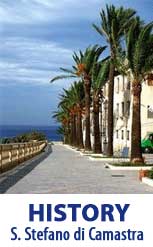S. Stefano di Camastra, a town in the province of Messina, was founded at the end of the 17th century by the Duke of Camastra who wanted to give the survivors of the landslide, which took place on 6 June 1682, the territory where one of the most important centers of the ceramic production in Sicily. The new town was therefore built by Don Giuseppe Lanza, Duke of Camastra, "indeed it can be said that it is one of his creations ... and he conceived it in its urban structure" The plan of the historic centre, a rhombus inscribed in a square, was conceived by the prince himself and has similarities with the eighteenth-century plants of the gardens of Versailles and the royal palace in Madrid. The town, built at 70 m. facing the Tyrrhenian Sea, it was founded near clay quarries, with particular characteristics, which subsequently meant its economic wealth. In the coastal strip of the town there were alluvial soils among which there was an abundance of "clayey or clayey-calcareous, heavy, not very permeable" soils suitable for working clay. A good part of the population of Stefano dedicated himself to the mining industry and consequently to the local manufacturing activity and the manufacture of crockery. The quarries of the clayey material were located in the area called "u chianu", met by Passo Barone, precisely called "turrazza" and were given to its founder by the tableware masters and their heirs without payment obligation, as can be read in the deed of notary Cristoforo Florena 2. The practice of extracting clay, however, is also noted in an ordinance of the Messina Finance Office issued on 6 February 1843. The so-called "stazzuna" were born near the clay quarries, where the "canals", the "pantofuli" and the "tivuli" began to be built, which were used above all at the beginning for the construction of the houses of the new town. The clay extracted from the quarries was generally transported "a bardo", on donkeys guided by the "carusi" (boys) who carried it to the various "putie" where it was kneaded with hands and feet inside a "pit", making it suitable for various processes. The "chianu" workshops, called "putie", have a more complex structure and represent the first true artisan workshops, where the "jars", the "quartari", the "bummuli", the "cannata", the "fiasco" the "brunia", objects present in the daily life of every Sicilian house. The JARS were mainly used to store oil and cereals. The linear hems traced on the belly during the turning phase were called "simi" and had a functional character, in practice they indicated the measuring capacity of the jar, in fact, there were jars of half a cantharus, a cantharus and a cantharus and a half . (one cantharus is equivalent to approximately 40 kg)
As early as the Neolithic age, ceramic finds have been found which have assumed a role of great importance for the knowledge of the history of our island. The first pottery found from this period is characterized by a very rich decoration stamped or engraved, revealed by incrustations of whitish material. The influence of the Greek civilization gives birth in Sicily to the production of black-gloss painted pottery, and later also of red glazed ceramics. But Sicily also welcomes the influences deriving from the West, in fact, from the same period is the presence of vases in the Iberian style of the "bell-shaped glass" at the end of the Neolithic age. In the first Sicilian period, alongside the oriental influence, a peaceful relationship with Malta coexists, which continues until the second Sicilian period. From this period are the findings in the tombs of local pottery and vases of Greek production.

These containers continue to be used in the Sicilian countryside and are characterized by an enamelled internal part. Speaking of the jar, we cannot fail to mention our Pirandello, who was inspired precisely by the Stefano jar for his famous story. Even today, the processing of this object follows an ancient technique, in fact, the base is shaped on the lathe, while the various bands are worked by hand and are subsequently attached to each other, based on the size of the object, by the master lathe on the lathe itself. The QUARTARA was intended, however, to contain water for domestic use and were manufactured by the "lanciddana". It could be of various shapes, with a high and narrow neck or with a paunchy body. Another object used to contain water was "U BUMMULU" and is similar to the quartara, but with a longer and narrower neck, this peculiarity prevented the liquid from pouring. The reason these containers kept the water chilled was due to its surface evaporation. In fact, the porosity of the terracotta meant that the heat was released outside without heating the contents. The CANNATA was a glazed terracotta mug used to contain wine. With a pot-bellied body and a wide looped mouth, it was sometimes equipped with a spout placed near the belly and the mouth had a mask that prevented the liquid from coming out when it was poured. The FIASCO was a cross in shape between the quartara and the bummulo and it too was used to contain wine. The BRUNIA was a container for domestic use used for storing tomato paste. Among the production of ceramics in S. Stefano, we also mention the human head vases that adorned the balconies of the town. But perhaps the main success of Stefano's ceramics was given by the variety of dishes for domestic use that were baked by the ancient furnaces of the Piscitello family. There were all sizes and they were also used to spread out the preserves in the sun. An ancient Stefanese tradition was to prepare, during Holy Week, ceramic plates painted with scenes from the passion of Jesus with moistened cereal seeds (u lavuru), which were then taken to the church and admired by all. Finally, among the ancient products, we cannot fail to mention the famous "bleeds" used in the pharmacy as containers for spices.



.jpg)















































